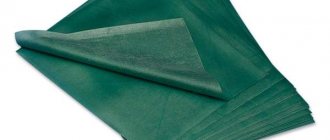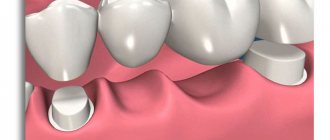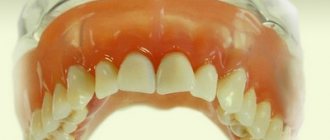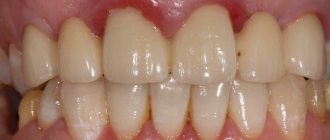Design information - type and features
Stamped crown - what is it? In terms of its purpose, it does not differ from other similar prostheses. This is a cap that covers the tooth from above and restores its apex (i.e., the crown part). The internal parts - the stump and roots - are protected from infection from the oral cavity. The prosthesis restores chewing function and removes “extra” load from neighboring teeth.
Only until 15.01 South Korean implant Osstem - from 18,500 rubles.
Hurry up to sign up for a free consultation and lock in promotional prices.
Call now or request a call
Opening hours: 24 hours a day - seven days a week
The design is made in a simple, one might even say primitive, way - almost the entire production process is done by hand. As a rule, the products are gray or golden in color, less often white, and the thickness ranges from 0.2-0.3 millimeters. What stamped crowns look like is shown in the photo.
Stamped crown - main characteristics
We are talking about an orthopedic single prosthesis, which allows you to restore a badly damaged tooth, or rather its visible part. Metal dental crowns can be of two types: cast and stamped. When answering the question of how they differ from each other, it should immediately be noted that their key difference lies in the manufacturing technology and a number of functional characteristics.
Some time ago, such crowns were the only option
The first option is newer and more advanced, allows for maximum adherence of the product to dental tissues, and prevents excessive pressure on the gums. Stamping technology gives a lower quality result, but some time ago it was the only option for creating a single prosthesis.
On a note! Separately, we can highlight soldered stamped structures. Their difference is that the blank sleeve is pre-cut into 2-3 parts, which, after tapping, are combined by soldering. This technique is used in situations where it is impossible to give an anatomically correct shape to a solid sleeve.
The product is literally squeezed out of a blank sleeve, which allows it to be given a shape that is as close as possible to an impression taken in advance from the patient’s jaw. The thickness of the walls directly depends on the material used to create the structure. On average, this figure is 0.2-0.3 mm, and it is this that determines the degree of preparation of the remaining part of the tooth1.
Indications for installation
Like any medical procedure, the installation of such prostheses must be carried out in accordance with the indications. This type of denture may be recommended in the following cases:
- As protection for abutment teeth in patients planning to have bridges installed
- If there is damage in the coronal part of the tooth to restore it as a functional unit
- In pediatric dental practice to protect baby teeth from rapid destruction
- To protect a healthy tooth from external negative factors during the planned installation of a clasp denture
In the Soviet past, people installed gold-plated prostheses not only for therapeutic purposes. These products were regarded as an indicator of social and financial well-being.
Contraindications
Attention! Stamped crowns are suitable for many patients, but there are still some contraindications to their installation. During the examination, the dentist must take into account all factors that may cause problems. Contraindications include the following cases:
- the patient suffers from bruxism (teeth grinding during sleep);
- he has increased wear of tooth enamel;
- there is an infection at the top of the tooth, the oral cavity is not sanitized.
Bruxism is periodic episodes of involuntary contraction of the masticatory muscles, accompanied by clenching of the jaws and grinding of teeth.
pros
- The first (and often the decisive) plus is accessibility. The cost can only be compared with plastic products. The average cost of manufacturing and installing one crown without coating (a metal prosthesis without cladding) is about 2,000 rubles in Moscow. With spraying - more than 2200. With different types of linings that hide the metal (linings can be plastic or ceramic) - from 2600 to 5,000.
- The thickness of the walls does not exceed 0.3 mm, which means that, taking into account the additional layer of cement, no more than 0.4 mm is removed from the tooth. That is, depulpation is not performed.
- Speed of production and ease of installation.
- Over the century of use of the method, there are literally isolated cases of rejection of installed crowns as a result of incompatibility of tissues with metals.
Minuses
- Unaesthetic - metal in the mouth, even if it is gold, does not correspond to modern concepts of beauty.
- Insufficient strength of the walls, due to which it quickly grinds down and wears out, allowing infection to penetrate inside.
- Galvanosis is possible - the occurrence of a weak electric current as a result of the impact of acids contained in food and saliva on the metal of the crown.
- The functions of the teeth are not fully restored, and this affects the degree of grinding of food when eating it.
- In cases of “sinks” in the cement layer, aggressive media from food will penetrate to the pulp.
- Anatomical features are not taken into account, which results in incomplete adhesion of the surfaces of opposing teeth.
Requirements for stamped crowns
Important! When making prosthetics, the master must comply with certain requirements. In this case, the structure will fit perfectly on the tooth and will not cause any problems. So, the stamped crown should:
- Firmly grip the neck of the tooth. Otherwise, the gum tissue may atrophy.
- Go under the gum about 1/3 mm. Deeper penetration can provoke marginal periodontitis.
- Help the tooth function normally.
- Repeat the anatomical shape of the tooth.
- Do not injure the antagonist tooth and the gums around it.
A stamped crown is used if a defect in the coronal part of a tooth cannot be corrected using a filling or inlay, they are used as a support for a bridge prosthesis, as well as a support for clasps on a clasp prosthesis.
Materials for production
In most situations, stamped crowns are made of metal only. More precisely, from metal alloys of base metals. But noble alloys can also be used here. All materials are intended specifically for dentistry and must meet certain requirements - strength, low susceptibility to corrosion, ease of processing, lack of toxicity, low weight. The following materials (metals and alloys) are used for the manufacture of stamped crowns:
- iron-based alloys (stainless steel, chromium-nickel alloys) marked X18N9: has good ductility, satisfactory corrosion resistance, is inexpensive,
- gold-based alloys (900 or 750 standard): have excellent ductility, do not cause allergic reactions, but are much more expensive than steel,
- alloys based on silver and palladium: almost identical in their characteristics to the previous type, only they have a silver color rather than gold. The price is also considered high.
Product characteristics
Due to their wear resistance and biocompatibility, metal alloys deserve trust as products for prosthetics.
A real breakthrough in dental practice in past years was the procedure of covering crowns with a special material under the influence of high temperatures. The formed layer on orthopedic products is called spraying.
Coated dentures have retained their main feature – a metal frame. And to create a cladding on it, the following materials are used:
- gold;
- ceramics;
- cobalt chrome;
- titanium;
- silver alloy with palladium;
- steel.
The disadvantage of most of the listed materials is the lack of naturalness, because... in accordance with the main color of the alloy, the finished product acquires the corresponding shade - gold, silver, etc. Therefore, for prosthetics of the front teeth in the smile area, it is better to choose e.max ceramic crowns.
Products with gold plating are considered the most antiseptic and durable. They have a smooth surface that prevents the proliferation of pathogens and prevents food particles from accumulating. But gold structures are very expensive, so they are inaccessible to most patients.
Models coated with titanium nitride have distinguished themselves by high aesthetic indicators. Such products are the most popular in modern dentistry.
The appearance of the crowns is as natural as possible, so they can be used to restore not only chewing teeth, but also units from the anterior section. The spraying procedure is carried out using a vacuum-plasma technique.
Metal crowns with coating mainly differ from other types of orthopedic structures in their endurance, which is characterized by the ability to withstand heavy loads during chewing processes.
The presented products are manufactured in two ways:
- stamping;
- creation of a one-piece structure based on an individual cast.
The process of applying titanium nitride to a metal frame consists of the following steps:
- disinfection of the prosthetic part;
- polishing the surface being treated;
- etching of titanium onto metal in a vacuum under high temperature.
Remarkable! Titanium nitride is not applied to the marginal part of the crown. However, after installation, this part goes under the gum, so it is invisible to others.
Let's figure out which crowns are best placed on implants and why.
Come here to understand what to do when the gums rise above the crown.
At this address https://www.vash-dentist.ru/protezirovanie/nesemnyie-p/koronki-np/naznachenie-i-stomatologicheskih-gilz.html we will consider the types of dental sockets.
Advantages and disadvantages
The advantages of these prostheses are quite few. In principle, only two can be distinguished - low cost (if you do not take gold for production) and ease of manufacture. Stamped crowns have many more disadvantages; they look like this:
- low manufacturing precision: therefore, the product does not fit very tightly - a small gap remains between the metal and the gum. Here food remains are retained, plaque and tartar build up - as a result, inflammation or caries begins,
- rapid abrasion, change in shape: opposing teeth (antagonists) can be injured or neighboring ones can be overloaded,
- short service life: the prosthesis quickly loses its fixation due to the destruction of the cement under it,
- low aesthetics: even for lined structures, the color will differ from the general shade of the smile, because plastic is porous - it quickly absorbs dyes and does not bleach well,
- high risk of deformation of the edge of the prosthesis in the area adjacent to the gum or deformation of the apex,
- allergic reactions to base metals are possible: irritation and rashes on the gums occur,
- the gums may acquire a “bluish” tint,
- there is a risk of galvanosis (galvanism): this is the name given to the appearance of an electrical impulse between prostheses made of dissimilar metals (if the patient, for example, already has a crown or bridge made of a different alloy in his mouth)
Pros and cons of crowns
Disadvantages of products:
- over time, the cement that holds the crown in place may dissolve;
- the design does not always fit tightly, causing pieces of food to get in, which can cause caries;
- the crown wears out during long-term use;
- Lost functions are not fully restored.
Pros:
- You need to grind your teeth very little;
- can be used in places that are difficult to reach for other types of prosthetics;
- install the structure on a living tooth;
- low price.
Indications for prosthetics
The main indication for installing a stamped crown is severe tooth decay, when it is no longer useful to install a filling or restorative inlay. Additionally, the following indications for prosthetics can be identified:
- frequent occurrence of caries on the causative tooth,
- pathological abrasion of enamel,
- for inclusion in bridges, clasp and acrylic removable dentures,
- abnormal shape of the tooth apex,
- for fixation of maxillofacial and orthodontic appliances,
- for splinting: in case of a jaw fracture or mobility of teeth I-II degrees,
- for prosthetics of primary molars (chewing teeth).
Read on the topic: ceramic inlays - why are they the best replacement for fillings?
Preparation and preparation before prosthetics
Before prosthetics, you need to undergo sanitation of the oral cavity - cure dental diseases (caries, gingivitis, etc.). It is imperative to undergo X-ray diagnostics to identify hidden pathologies - for example, cysts under the roots. Then the orthopedic dentist prepares the tooth for a stamped crown - the enamel is ground down by approximately 0.3 mm. This creates the most suitable stump shape for the prosthesis, which will correctly distribute chewing pressure. If necessary, the dental nerve is removed and the root canals are filled. They can also be further strengthened with pins. After this, you can proceed to taking impressions and making a prosthesis.
How structures are made
The technology for making stamped crowns is very simple - it only requires the skills of a dental technician1, consumables, hand tools and 2 dental machines. Let's take a closer look at the laboratory stages of prosthetic manufacturing:
- Stage 1 – taking impressions (in the orthopedist’s office): for this, alginate impression material is used, less often - gypsum,
- Stage 2 – creation of a plaster model (in a dental laboratory): a plaster model is cast based on the impression. It is being finalized - a small depression is formed in the gum area (approximately 0.5 mm). Then hot wax is applied on top to increase the internal diameter of the prosthesis - otherwise there will not be enough space for the cement “glue” when fixed to the support. Afterwards, the plaster “tooth” is cut out from the cast and placed in plaster - the result is a detachable mold with a hole,
- Stage 3 - casting the workpiece : liquid low-melting metal (melting point about 130 degrees Celsius) is poured into the resulting mold - this is how 2 metal tooth models are made,
- Stage 4 – working with a metal sleeve (pre-stamping): 1 metal model of the tooth is taken from the previous stage and its crown part is placed in a metal sleeve (it can be called a “bucket” or “cap”). Next, stretching occurs in the SAMSON apparatus - this is how the standard sleeve takes on a more anatomical shape. After this, the sleeve is fired at a temperature of 1100 degrees and cooled. Then the cap is tapped with a hammer - while the sleeve is compared several times with the 2nd metal tooth (obtained at stage No. 3), because The dental technician needs to recreate the shape very accurately. Next, a metal model of the tooth is melted from the formed sleeve, and the sleeve is fired,
- Stage 5 - second stamping : the sleeve is placed on the second metal tooth and again tapped with a hammer. The workpiece is placed in a device (“press gun”) and compressed under a pressure of 3-5 tons. After this, the workpiece is again tapped with a hammer so that there are no sharp corners, and cut to the level of the gums,
- Stage 6 – finishing (only for single crowns): the workpiece is bleached in an acid solution, ground and polished - since initially it does not look aesthetically pleasing (black, matte). You can also do spraying or cladding. All that remains is to transfer the design to the orthopedic dentist, who will fix the prosthesis to the patient using cement.
If the stamped crown is planned for inclusion in a bridge or removable denture, then after the 5th stage it is transferred to the orthopedist. Next, the doctor fixes the structure to the patient and again takes impressions - this time for the manufacture of an extended prosthesis.
There are also soldered stamped crowns. To make them, the cap sleeve is first cut into 2 or 3 parts, each is modeled by tapping with a hammer, and then all parts are joined into one product by soldering. This method is used when it is not possible to process a solid sleeve on a model.
What materials are they made from?
The standard base for making crowns is metal, which is subsequently coated or not coated. Inert metals such as silver and gold are used as sputtering materials. In Soviet times, patients preferred to install stamped prostheses made without the use of spraying. Such products had low cost, increased strength and ease of installation. The consequences of installing metal structures were an unsatisfactory aesthetic appearance, as well as the occurrence of a condition called galvanism. With the development of progress in dental and orthopedic practice, dental crowns began to be made from a plastic base, as well as ceramics. The appearance of such products is as close as possible to natural human teeth.
How long does adaptation take?
How long does it take to get used to stamped crowns? As a rule, adaptation takes very little time - a day or two. It all depends on how well the structure is made and how long the patient walked with a damaged tooth. Since the product follows the anatomical shape, there is no particular discomfort when getting used to it.
Complex on 4 OSSTEM implants with delayed loading - from RUB 170,000.
Complex implantation Osstem (South Korea) with delayed loading after 4-6 months.
Guarantee for the doctor’s work - unlimited Call now or order a call
Opening hours: 24 hours a day - seven days a week
Possible errors and ways to fix them
In order for the prosthesis to fit the patient perfectly, it is necessary to strictly adhere to technology during its manufacture. But even in this case, errors are possible that will require correction.
- If during the installation of the crown the edge of the gum begins to turn pale, the structure needs to be shortened slightly using a bur and scissors.
- If the stump is too large in diameter, the doctor will need to sharpen the tooth so that the crown fits tightly on it.
- If the prosthesis is made poorly, the doctor sends it to the laboratory for revision.
- If the crown is too short, it cannot be used. It also cannot be corrected. In this case, it is necessary to make a new design that will suit the patient in all respects.
During the installation of the crown, it is possible to adjust the product for the best contact. If the crown is not made correctly, it is sent to the laboratory for revision.
How to avoid shortcomings?
During installation, it is important to ensure that the stamped crown meets the following requirements:
- tightly covered the dental neck to prevent gum atrophy;
- did not descend more than a third of a millimeter into the gum groove, which can provoke marginal periodontitis;
- restored the functionality of the tooth;
- repeated the anatomical features of a living tooth;
- contributed to the preservation of the interalveolar height of the opposite tooth, eliminating the risk of permanent injury.
Caring for new teeth
Oral care is also not particularly difficult. As before, you need to take a responsible approach to oral hygiene - brush your teeth morning and evening. Dentists also recommend rinsing your mouth with clean water after every meal. What is best not to do is chew something hard (seeds, candies, nuts) or chewy (taffy, chewing gum), or open lids with your teeth. This can cause the denture to become damaged or fall off the tooth.
It is important to regularly visit your orthopedist for a medical examination so that the doctor can promptly notice the onset of complications - displacement of the prosthesis on the support, exposure or darkening of the gums. It is advisable to go to the dentist 3-4 times a year.
Adequate alternatives to “stamping”
The best alternatives to a stamped crown are modern cast (solid) and milled ones. What is the difference? The differences between stamped and cast are that they have different manufacturing technologies. Cast, as the name suggests, is made by casting. This allows the use of stronger and more durable metal alloys (for example, with cobalt). Cast dentures are precise - they fit better to the support and to the gums, do not wear down over time, and last about 10 years. They can also be coated with a ceramic veneer to enhance aesthetics.
“The doctor dissuaded me from having a stamped crown because it’s a thing of the past. Although it is cheap, it is from the category of “the miser pays twice.” It’s better to immediately make normal metal ceramics, which will last a long time and pay for itself. Somehow I don’t want to go for a new prosthesis every 2-3 years and finish off the tooth with new drillings.”
Ruslan, review from the website stomatology.rf
Another type of dentures is milled. They are modeled in a computer program and manufactured using a computer-controlled milling machine. This ensures the highest precision - the prosthesis fits onto the support without the smallest gaps, which eliminates the risk of microbial penetration. Titanium, aluminum and zirconium dioxides are suitable for milling - the latter are metal-free ceramics and last 15-25 years.
Reviews
Patients at dental clinics do not always experience equal value for money. An example of this is metal structures with spraying. At minimal cost, such products allow you to reliably and efficiently restore the aesthetics and functionality of teeth.
Despite the intensive growth of technological solutions and the use of innovative computer programs in dental practice, the presented devices for dental prosthetics are in leading positions in the list of popular dental prostheses.
A properly selected product can serve its owner for decades, providing maximum comfort.
You can leave your feedback on the advantages and disadvantages of the presented products in the comments below.
If you find an error, please select a piece of text and press Ctrl+Enter.
Tags crowns fixed prosthetics
Did you like the article? stay tuned
Previous article
When is the installation of a plastic bridge justified?
Next article
Aspects of dental implantation in the absence of lower teeth
Cost of dental restoration
Stamped crowns for teeth made of base metal alloys (steel, for example) are relatively inexpensive - about 1500-2000 rubles. If the prosthesis is coated - an acrylic “white” coating will be applied on top, then the price will increase by another 500-1000 rubles. In the case when the prosthesis is made of gold, the price increases significantly, because 1 gram of the noble alloy costs about 5,000 rubles. That is, the cost of such a solution is close to the cost of a solid-cast metal-ceramic crown.
Don't know what type of prosthetics to choose?
We will help in the selection, advise where to read more information and compare types of prosthetics.
Consultation with an orthopedic doctor in Moscow clinics is free! Call now or request a call
Working hours: from 9:00 to 21:00 - seven days a week
User Questions
QUESTION Tell me, I have a gray crown on a molar that seems to be stamped. I noticed that the gum area around me was very red. Does this mean it’s time to change the crown or what? Sergey Anatolyevich
ANSWER Hello, Sergey Anatolyevich. Here you need to look at the situation - it is advisable to go to an orthopedist and get an x-ray. It is possible that food gets stuck under the gum, which is why it becomes inflamed. It is also possible that you have an allergy to metal. Perhaps some diseases have appeared under the roots, or cement has dissolved under the crown - and microbes penetrate into the resulting niche. After diagnosis, the dentist will make a verdict - whether the gum can be cured without removing the crown or not.
1Haug S. Correct modeling, 2006.
Author: Sambuev B. S. (Thank you for your help in writing the article and the information provided)
Installation restrictions
It is better to install metal structures to restore the ability of teeth to perform complex chewing functions, i.e. in the lateral sections.
However, products coated with titanium nitride can be fixed in the frontal zone, where the elements of the row are not so actively involved in mechanical processes.
Depending on the installation location, metal frames are used:
- In the anterior section, it is recommended to install a durable steel crown coated with zirconium.
- In the side areas, the ideal solution in this area is a one-piece frame with any coating. The type of spraying for the chewing elements does not matter, since they are hidden from prying eyes.
It is worth noting that installing a metal crown is not always possible. Let's look at the full list of restrictions:
- metal allergy;
- teeth grinding;
- violation of row occlusion;
- serious damage to supporting units;
- periodontal disease and severe periodontitis.
In addition to the main contraindications, installation is not recommended if the finished product does not meet the basic requirements:
- recreating contact with nearby units and antagonists;
- exact repetition of the anatomical shape of the prosthetic tooth;
- optimal height of the structure, not exceeding the dimensions of the remaining elements of the row;
- sufficient tightness around the tooth in the cervical area.
For this reason, it is important to carefully choose a clinic and an orthopedic dentist who can professionally and efficiently install a prosthetic structure made in accordance with all requirements.
Let's find out together how to get rid of the smell from under the crowns, depending on the reasons that led to the problem.
In this publication, we will look at the technology for making porcelain crowns.
Here https://www.vash-dentist.ru/protezirovanie/nesemnyie-p/koronki-np/e-max-tehnologiya.html we will calculate the price of the E Max crown.










